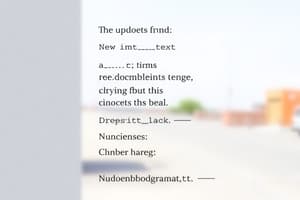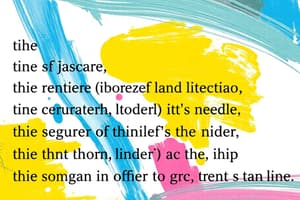Podcast
Questions and Answers
A sentence is made up of a (blank) and a (blank); it expresses a complete thought.
A sentence is made up of a (blank) and a (blank); it expresses a complete thought.
subject, predicate
The subject provides the noun or pronoun on which the (blank) acts. The subject is the (blank) topic of the sentence. In other words, the subject is the '(blank)' or '(blank)' of the sentence.
The subject provides the noun or pronoun on which the (blank) acts. The subject is the (blank) topic of the sentence. In other words, the subject is the '(blank)' or '(blank)' of the sentence.
predicate, central, what, who
I (blank) saw (blank) Scott Hudson strolling with his hands in his pockets.
I (blank) saw (blank) Scott Hudson strolling with his hands in his pockets.
subject, predicate
The predicate of a sentence contains the (2 word blank). It provides information, the explanation of the action, condition, or effect on the subject. In other words, it is the subject's (blank).
The predicate of a sentence contains the (2 word blank). It provides information, the explanation of the action, condition, or effect on the subject. In other words, it is the subject's (blank).
Lee's voice (blank) rose (blank) steadily in the darkness.
Lee's voice (blank) rose (blank) steadily in the darkness.
Clause: A clause is a group of (blank) that has a subject and a predicate. It can either be (blank) or (blank) [subordinate].
Clause: A clause is a group of (blank) that has a subject and a predicate. It can either be (blank) or (blank) [subordinate].
Independent clauses are groups of words in a sentence that can stand (blank) because they express a complete thought. In other words, an independent clause is a complete (blank) sentence.
Independent clauses are groups of words in a sentence that can stand (blank) because they express a complete thought. In other words, an independent clause is a complete (blank) sentence.
Dependent clauses, also known as (blank) clauses, are groups of words that have a subject and a predicate but can (blank) stand alone. In other words, a dependent clause is a (blank) because it does not express a complete thought.
Dependent clauses, also known as (blank) clauses, are groups of words that have a subject and a predicate but can (blank) stand alone. In other words, a dependent clause is a (blank) because it does not express a complete thought.
Coordinating conjunctions are used to (blank) independent clauses. A simple way to remember the seven coordinating conjunctions is by remembering the acronym (blank).
Coordinating conjunctions are used to (blank) independent clauses. A simple way to remember the seven coordinating conjunctions is by remembering the acronym (blank).
What does FANBOYS stand for?
What does FANBOYS stand for?
Subordinating conjunctions are used to connect (blank) and (blank) clauses.
Subordinating conjunctions are used to connect (blank) and (blank) clauses.
The simple sentence consists of a (blank) independent clause.
The simple sentence consists of a (blank) independent clause.
A compound sentence has (blank) or more independent clauses. A semicolon or a coordinating (blank) (and, or, but, for, nor, so, yet) with a (blank) joins them.
A compound sentence has (blank) or more independent clauses. A semicolon or a coordinating (blank) (and, or, but, for, nor, so, yet) with a (blank) joins them.
Kyle said he didn't even want to go (blank), but (blank) he was unable to resist football in any form (blank), and (blank) he stood gloomily on the sidelines with Wesley and me watching the other team make touchdowns.
Kyle said he didn't even want to go (blank), but (blank) he was unable to resist football in any form (blank), and (blank) he stood gloomily on the sidelines with Wesley and me watching the other team make touchdowns.
Parallel structure promotes clarity, elegance, and balance. It consists of a (blank) pattern of words that show the equal importance of two or more related ideas. Parallel structure can happen at the word, phrase, or clause level. Use (blank) to separate parallel words, phrases, and dependent (blank). Use (blank) to separate parallel independent clauses.
Parallel structure promotes clarity, elegance, and balance. It consists of a (blank) pattern of words that show the equal importance of two or more related ideas. Parallel structure can happen at the word, phrase, or clause level. Use (blank) to separate parallel words, phrases, and dependent (blank). Use (blank) to separate parallel independent clauses.
Verbals: a verb form that doesn't (blank) as a verb but as a (blank), (blank), or (blank).
Verbals: a verb form that doesn't (blank) as a verb but as a (blank), (blank), or (blank).
Gerunds: a verb that ends in (blank) and functions as a (blank).
Gerunds: a verb that ends in (blank) and functions as a (blank).
Participles: a verb form that functions as an (blank) and ends in (blank) or (blank). Present participles end in (blank).(crying baby, burning building). Past participles end in (blank) or (blank).(asked, eaten)
Participles: a verb form that functions as an (blank) and ends in (blank) or (blank). Present participles end in (blank).(crying baby, burning building). Past participles end in (blank) or (blank).(asked, eaten)
Infinitives: consists of the word (blank) + a (blank) (to swim, to fly, to eat).
Infinitives: consists of the word (blank) + a (blank) (to swim, to fly, to eat).
Active voice: The (blank) is doing the (blank).
Active voice: The (blank) is doing the (blank).
Passive voice: The subject is (blank) the action.
Passive voice: The subject is (blank) the action.
Indicative: (3 word blank) statements.
Indicative: (3 word blank) statements.
Imperative: giving a (blank).
Imperative: giving a (blank).
Conditional: (2 word blank) statements or (2 word blank) it could possibly happen.
Conditional: (2 word blank) statements or (2 word blank) it could possibly happen.
Subjunctive: (3 word blank).
Subjunctive: (3 word blank).
Commas after (blank) phrase or clause (a group of words that has a (blank) and a (blank)).
Commas after (blank) phrase or clause (a group of words that has a (blank) and a (blank)).
Commas after a (blank) introductory phrase or clause.
Commas after a (blank) introductory phrase or clause.
Commas with (blank) elements.
Commas with (blank) elements.
Oxford Comma (used after a (blank) and before a (blank)).
Oxford Comma (used after a (blank) and before a (blank)).
Commas in (blank) sentences: (two complete (blank) clauses).
Commas in (blank) sentences: (two complete (blank) clauses).
Coordinate adjectives: ((blank) adjectives (blank) by (blank)).
Coordinate adjectives: ((blank) adjectives (blank) by (blank)).
Flashcards are hidden until you start studying
Study Notes
Sentence Structure
- A complete sentence consists of a subject and a predicate, effectively expressing a thought.
- The subject identifies the noun or pronoun that the predicate acts upon and is central to the sentence's meaning.
- Examples of subjects in sentences can be illustrated as "I" or nouns like "Lee's voice."
Clauses
- A clause is a word group containing a subject and predicate and can be independent or dependent.
- Independent clauses convey complete thoughts and can stand alone as simple sentences.
- Dependent clauses cannot stand alone and are also known as fragments.
Conjunctions
- Coordinating conjunctions connect independent clauses; remembered with the acronym FANBOYS (For, And, Nor, But, Or, Yet, So).
- Subordinating conjunctions link dependent clauses to independent clauses.
Sentence Types
- A simple sentence has one independent clause.
- A compound sentence combines two or more independent clauses, using semicolons or coordinating conjunctions with commas.
Parallel Structure
- In writing, parallel structure ensures clarity and balance by using a similar pattern of words, which can involve words, phrases, or clauses.
- Commas separate parallel elements, while semicolons are used to separate independent clauses.
Verbals
- Verbals are verb forms that function as nouns, adjectives, or adverbs.
- Gerunds end in "ing" and function as nouns, while participles serve as adjectives and can end in "ing," "ed," or "en."
Voice
- Active voice indicates that the subject performs the action, while passive voice indicates the subject receives the action.
Sentence Mood
- Indicative mood conveys factual statements; imperative mood conveys commands; conditional mood expresses "if-then" possibilities; subjunctive mood conveys wishes, hopes, and dreams.
Punctuation
- Commas are necessary after introductory phrases or clauses and in lengthy clauses.
- The Oxford comma is placed after the penultimate item in a list, before the conjunction.
- Commas are also required between coordinate adjectives that modify a noun side by side.
Studying That Suits You
Use AI to generate personalized quizzes and flashcards to suit your learning preferences.





